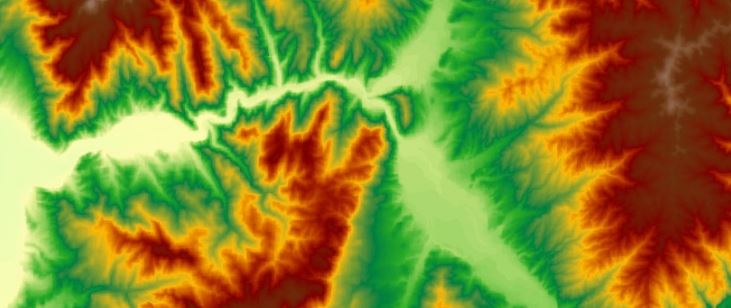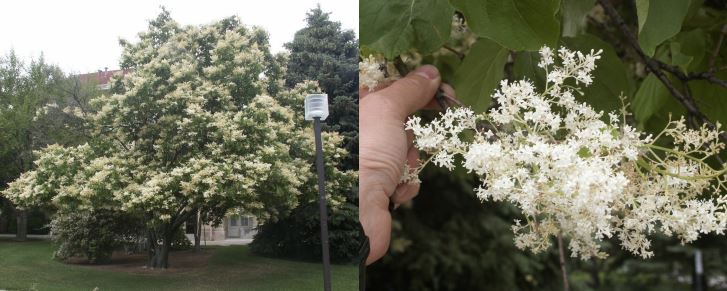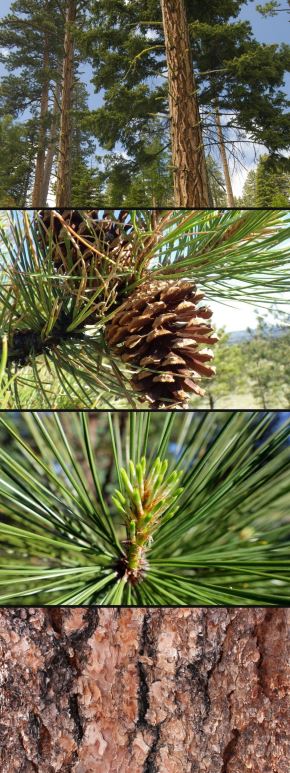028 - Selecting Trees for High Elevations
Background
Utah is home to some of the highest peaks in the country, and it is the third highest state in the country, behind Colorado and Wyoming. Though most Utahns live in the low valleys where year-round living is easiest (in terms of snowfall), many people want to live at high elevations where they can enjoy recreation, wildlife, and scenery that is easily accessible. These high elevation inhabitants may wish to landscape the property surrounding their primary residence while others may have trees they need to care for at a cabin or summer home site in the mountains. This factsheet can help homeowners select, cultivate, and care for the trees suited to these high elevation places.
Why is Elevation Important?
In this fact sheet, the term high elevation will refer to elevations above 5,000 feet. High elevation sites are both good and bad for trees. They have shorter growing seasons because the frost-free period is shorter. Temperatures decrease 5 degrees (F) for every 1,000 foot increase in elevation. Situated at 7,000 feet and higher, Park City can be 20 degrees cooler on average than Salt Lake City at 4,200 feet. Also there is an average 1 degree decrease in temperature for every degree farther north in latitude at the same elevation.

An example of the varied terrain found in Morgan County, Utah. Red and yellow colors indicate high elevation terrain.

Japanese tree lilac is one recommended species for high elevation planting sites in Utah.
Elevation: A Mixed Bag for Trees
Besides being cooler and having a shorter growing season, elevation has several other important effects on trees, both positive and negative.
Positive Effects of Higher Elevation on Trees Are Nearly All Water Related
- Increased precipitation, water availability and organic matter in soil.
- Decreased evapotranspiration and generally decreased stress.
- Less temperature extremes which may lead to lower stress overall.
- Slower snow melt due to lower temperatures, which increases soil moisture retention later into summer.
- Higher elevation sites tend not to have the high soil pH and salinity problems that low elevation sites have.
Negative Effects of Higher Elevation on Trees Include

Ponderosa pine (Pinus ponderosa). Photo courtesy Flickr user: bllg-water, Matt Lavin, Stuart Rankin and USU Forestry Extension.
- Extreme low temperatures during the winter can cause dieback in any tree and loss of or damage to foliage in evergreens.
- Variation in the timing of the last frost in spring, or the first frost in fall, can make it difficult to select species that are appropriate for such areas over the long term. Published hardiness zones may not be accurate for this reason. For example, a late frost in early summer can severely damage trees that have leafed out, even native trees. An early frost in the fall can damage trees that have not yet gone dormant.
- Fluctuating frost times and lower ‘high’ temperatures also shorten the growing season so plants grow more slowly over the years.
- Slower snow melt can mean lower water availability where soils stay frozen into the growing season.
- Heavy snow loads at high elevations can cause bending and breaking of branches or even trunks for weak species and cultivars.
Aspect
Aspect is especially important for trees growing at high elevation and where there are steep slopes. Aspect is the direction a slope faces. Aspect is important because (in the northern hemisphere) more solar radiation is available on south-facing slopes than north-facing slopes. South-facing slopes will have earlier snow melt, lower soil moisture, and lower humidities than nearby north-facing slopes, and plants will be warmer so they will lose water more quickly. Northfacing slopes have the opposite characteristics.
In addition, east facing slopes on average get the same amount of sun as west facing slopes, but they get it early in the day when the site is still cool from the night. West facing slopes get their sun late in the day when temperatures are higher, so they are typically drier sites. In general you can think of east to north facing slopes as being the coolest and wettest and south to west facing slopes as being the warmest and driest. However, though a northeast slope may have more moisture, its coolness may mean earlier frost and soils that stay frozen longer, so plants may grow slower.
Tree Selection for High Elevation
Choosing the right tree for your high elevation site can mean the difference between planting success and failure. This doesn't just mean choosing the right tree for your general area, but it also means choosing the right tree for a specific place in your landscape, or a particular microsite (see microsite box below). Temperature and frost-related microsite factors are the most critical for tree survival. If you are trying a species that is marginally cold hardy for your site, put it in an area that gets cold and stays cold in winter. For example place it on the north side of a building or somewhere else where there isn’t much winter sun. If a tree is relatively cold hardy but you are unsure whether it will survive the harsh winter, plant it close to a building on either the south or west side to take advantage of the building’s thermal mass. This will help the tree get through the coldest nights. Trees being planted for their flowers (and fruit) should usually go on the warmest microsites you have. Otherwise the tree may survive, but the flowers may be killed in the bud by extremely low temperatures or by late frosts.
Recommendations
In most cases it make sense to select species that have a moderate to slow growth rate versus species that grow rapidly. Fast growing trees tend to be weak-wooded and more vulnerable to insects and diseases. At high elevations in Utah we recommend selecting species suitable for USDA Zone 4b or lower. In the USU Tree Browser there are 137 species that are recommended. for Zone 4b or lower; 26 of these species are native to Utah. Of course, as mentioned previously, the hardiness zone does not take into account the effect of unusually late or early frosts on a tree. A good way to tell is to walk through your neighborhood and observe what trees have survived nearby. It’s hard to argue with success!
Trees for High Elevations
| Type | Scientific Name | Common Name (* indicates native to Utah) | Hardiness Zones |
|---|---|---|---|
| Conifer | Abies concolor | Fir, White* | (3-7) |
| Conifer | Abies lasiocarpa | Fir, Subalpine (cool sites only)* | (4-6) |
| Conifer | Juniperus chinensis | Juniper, Chinese | (4-9) |
| Conifer | Juniperus scopulorum | Juniper, Rocky Mountain* | (3-7) |
| Conifer | Juniperus virginiana | Redcedar, Eastern | (2-9) |
| Conifer | Larix decidua | Larch, European | (2-6) |
| Conifer | Larix kaempferi | Larch, Japanese | (4-6) |
| Conifer | Picea abies | Spruce, Norway | (2-7) |
| Conifer | Picea engelmannii | Spruce, Engelmann* | (2-5) |
| Conifer | Picea glauca | Spruce, White | (2-7) |
| Conifer | Picea omorika | Spruce, Serbian | (4-7) |
| Conifer | Picea pungens | Spruce, Blue* | (2-7) |
| Conifer | Pinus aristata (longaeva) | Pine, Bristlecone* | (5-7) |
| Conifer | Pinus cembra | Pine, Swiss Stone | (3-7) |
| Conifer | Pinus flexilis ‘Vanderwolf’s Pyramid’ | Pine, Vanderwolf’s Pyramid Limber* | (4-7) |
| Conifer | Pinus heldreichii | Pine, Bosnian | (5-7) |
| Conifer | Pinus nigra | Pine, Austrian | (4-7) |
| Conifer | Pinus ponderosa | Pine, Ponderosa* | (3-7) |
| Conifer | Pinus sylvestris | Pine, Scotch | (2-8) |
| Conifer | Pseudostuga menziesii var. glauca | Fir, Douglas (glauca variety)* | (4-6) |
| Broadleaf | Acer ginnala | Maple, Ginnala or Amur | (3-8) |
| Broadleaf | Acer glabrum | Maple, Rocky Mountain (5,000 to 12,700 ft.)* | (4-7) |
| Broadleaf | Acer grandidentatum | Maple, Bigtooth (4,200 to 9,400 ft.)* | (4-7) |
| Broadleaf | Acer tataricum | Maple, Tatarian | (3-8) |
| Broadleaf | Amelanchier species | Serviceberries* | (3-8) |
| Broadleaf | Betula occidentalis | Birch, Western Water (3,000 to 10,000 ft.)* | (3-7) |
| Broadleaf | Cercocarpus ledifolius | Mountain-mahogany, Curlleaf* | (3-8) |
| Broadleaf | Crataegus douglasii | Hawthorn, Douglas* | (3-9) |
| Broadleaf | Crataegus phaenopyrum | Hawthorn, Washington | (3-8) |
| Broadleaf | Ginkgo biloba | Ginkgo | (3-9) |
| Broadleaf | Gymnocladus dioicus | Coffeetree, Kentucky | (3-8) |
| Broadleaf | Malus spp. | Crabapple | (4-7) |
| Broadleaf | Ostrya virginiana | Hophornbeam, Eastern | (4-9) |
| Broadleaf | Populus tremula | Aspen, Swedish | (2-7) |
| Broadleaf | Populus tremuloides | Aspen, Quaking* | (3-7) |
| Broadleaf | Prunus maackii | Chokecherry, Amur | (3-6) |
| Broadleaf | Prunus virginiana | Chokecherry, Canada Red* | (2-6) |
| Broadleaf | Quercus macrocarpa | Oak, Bur | (2-8) |
| Broadleaf | Quercus gambelii | Oak, Gambel* | (4-8) |
| Broadleaf | Sorbus scopulina | Mountain-ash, Greene* | (2-5) |
| Broadleaf | Syringa reticulata | Lilac, Japanese Tree | (3-8) |
| Broadleaf | Tilia cordata | Linden, Littleleaf European | (3-7) |
Resources
- Visit the USU Tree Browser website for photos, hardiness zones and identification information for over 240 tree species.
- Hardiness zone table from USU Forestry.
Acknowledgement and Additional Information
Published August 2015.

